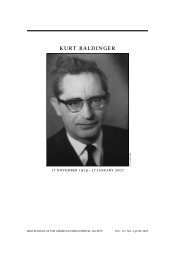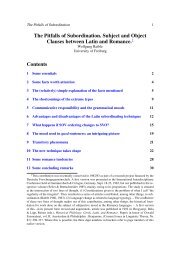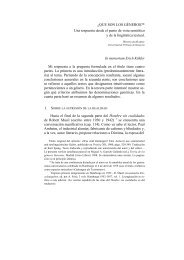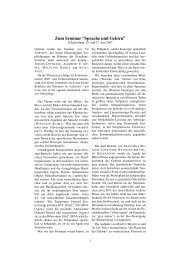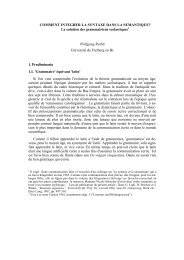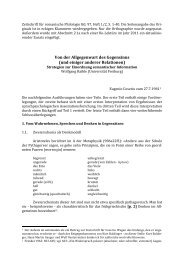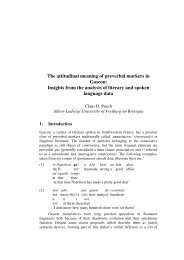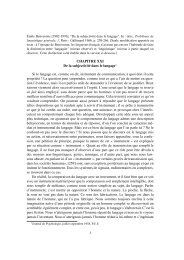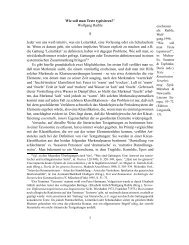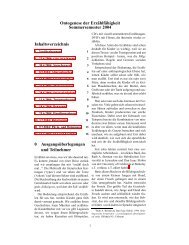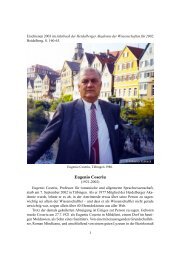A Summary of Role and Reference Grammar
A Summary of Role and Reference Grammar
A Summary of Role and Reference Grammar
Create successful ePaper yourself
Turn your PDF publications into a flip-book with our unique Google optimized e-Paper software.
The decompositional representation <strong>of</strong> a predicate is referred to as its ‘logical structure’<br />
[LS]. Examples <strong>of</strong> English verbs (<strong>and</strong> also some non-verbal predicates) with their LSs are given<br />
in (8). The order <strong>of</strong> arguments will be discussed in the next section.<br />
(8) a. States<br />
Sam is a lawyer. be´ (Sam, [lawyer´])<br />
The vase is shattered. shattered´ (vase)<br />
Chris is at the <strong>of</strong>fice. be-at´ (<strong>of</strong>fice, Chris)<br />
Kim saw the photo. see´ (Kim, photo)<br />
b. Activities<br />
The door squeaks. do´ (door, [squeak´ (door)])<br />
Lee drank beer. do´ (Lee, [drink´ (Lee, beer)])<br />
c. Achievements<br />
The vase shattered. INGR shattered´ (vase)<br />
The bubble popped. INGR popped´ (bubble)<br />
d. Semelfactives<br />
Lee sneezed. SEML do´ (Lee, [sneeze´ (Lee)])<br />
Chris glimpsed Pat. SEML see´ (Chris, Pat)<br />
e. Accomplishments<br />
The water froze. BECOME frozen´ (water)<br />
The sky reddened. BECOME red´ (sky)<br />
Kim learned Swahili. BECOME know´ (Kim, Swahili)<br />
f. Active accomplishments<br />
Lee drank a beer. do´ (Lee, [drank´ (Lee, beer)]) & INGR drunk´ (beer)<br />
Paul ran to the store. do´ (Paul, [run´ (Paul)]) & INGR be-at´ (store, Paul)<br />
g. Causatives<br />
The dog scared the boy. [do´ (dog, Ø)] CAUSE [feel´ (boy, [afraid´])]<br />
Mary broke the pencil. [do´ (Mary, Ø)] CAUSE [BECOME broken´ (pencil)]<br />
The cat popped the bubble. [do´ (cat, Ø)] CAUSE [INGR popped´ (bubble)]<br />
Fred rolled the ball. [do´ (Fred, Ø)] CAUSE [do´ (ball, [roll´ (ball)])]<br />
Despite having ‘INGR’ in their LSs, the telic use <strong>of</strong> activity verbs is, following the literature, referred<br />
to as ‘(active) accomplishments’.<br />
In many languages, verbs in these different classes may be overtly morphologically inflected<br />
to signal their class, <strong>and</strong> verbs in different classes may be morphologically related to each other.<br />
State predicates are the basis <strong>of</strong> change <strong>of</strong> state verbs, achievements <strong>and</strong> accomplishments, <strong>and</strong><br />
these in turn are the basis for causative change <strong>of</strong> state verbs, causative achievements <strong>and</strong> accomplishments.<br />
There are languages which represent these relationships explicitly in their verbal<br />
morphology. These languages fall into a number <strong>of</strong> groups (Haspelmath 1993), two <strong>of</strong> which<br />
will be discussed here. In the first group, the base is a state predicate, either a verb or an adjective,<br />
<strong>and</strong> to this base a morpheme is added indicating BECOME or INGR, deriving an accomplishment<br />
or achievement. Then to this derived form is added a causative morpheme, deriving a<br />
causative accomplishment or achievement. In Qiang, a Tibeto-Burman language (Van Valin &<br />
LaPolla 1997), the relationship is straightforward: ba ‘big’ [state], të-ba ‘become big’ [accom-<br />
11



